Trucks and Fins is a huge present to the whole skate community - not just for the skating people, but also for shops, builders and schools. Super easy to use and can't believe how complete it is.
Pascal Lieleg aka Official Bowlshit
Steep down hills, iconic street spots and valid concrete parks, Bilbao is definitely one of Europe's coolest places to be. Last February I went to Bilbao to do some park hunting and check out the local skate scene. My favorite 8? Here they go.
If street is your thing, go to EMB. The spot consists of a statue surrounded by different shaped legdes and blocks, with a perfect flat ground. About a decade ago the city hall wanted to destroy the park, but local skaters fought back and won the battle against the city bureaucrats. Since that day skaters have been organizing the yearly EMB4EVER event to celebrate and remember their victory.

Trapaga skatepark is located on the west side of the river in Valle de Trapaga, just outside Bilbao. The park features a fast and smooth bowl, built by Zutskateparks, that is definitely worth a visit if you are in the area and looking for a mellow park to cruise around.

Looking for halfpipes or verts? Bilbao has loads of options eg. La Kantera, Areeta, Ansio, Etxerre and Basozelai skatepark. The park also features an open bowl and transition area.

Have you ever dreamed about the longest grind you could possibly do in transition? Good news... here is one with about 18m length of coping. Another good thing? You don’t have to check the weather forecast cause this park has a rooftop. The park also offers a lot of space for flatground tricks and street skating. The surface is super smooth to skate and the bowl and miniramp are definitely worth it‘s money.

This concrete park, is located in the centre of Bilbao and has a fun little street section, but the main attraction of the park is definitely the bowl with pool coping.

Looking for a spot for an oldschool bowl session? Check out Sondika skatepark, made up of several flat ledges, and a bowl with stone coping. Definitely worth a visit.

Want to enjoy a session at the beach whilst enjoying a stunning scenery? Sopelana is the place to be. The bowl has a good mix of different type of transitions for beginners, advanced and pros. In the evening it can get crowded until the sun goes down.

Number one of the list is definitely Spain's most inconic park La Kantera, aka Algorta skatepark, built in 1987, thanks to the initiative of a group of local surfers and skaters. In the beginning legends like Txus Domínguez, Alain Goikoetxea, Ivan Fano, Afonso Fernandez etc turned La Kantera into the Mecca of skate in Spain, inspiring the following generations of skaters. 35 years later the park is still a worldwide reference for its radical and creative approach to skateboarding.

Join the Trucks and Fins community and receive exclusive news, giveaways, access to subscribers-only
-contests, discounts from our partners and much more directly from us!

Trucks and Fins is a huge present to the whole skate community - not just for the skating people, but also for shops, builders and schools. Super easy to use and can't believe how complete it is.
Pascal Lieleg aka Official Bowlshit

Trucks and Fins is a great resource for checking on local spots if you are traveling or planning a road trip! A one stop resource that is constantly updated with the newest projects as well as those bucket list locations worldwide. The intuitive UI features gps coordinates as well as useful information about shops nearby.
Architect Betonlandschaften

Trucks and Fins provide a great service. Its quick and easy to use and has such a vast amount of parks included, not just in the UK but worldwide. CANVAS Spaces support the cause and fully back what they are doing.

Our skate community has been crying out for a comprehensive guide to global skate spots. Trucks and Fins should be commended on their dedication to mapping the world's STOKE!
Maverick Skateparks

Trucks and Fins brings all of the world's skateparks to you all in one convenient place through their endless search for parks around the world. They have park locations, details, images, and more to help plan your next skate quest wherever that may take you. We appreciate their dedication and passion for skateboarding and the amazing gifts that skateparks and skate spots are.
Steve Zanco, Skatepark Respect

A big part of skateboarding is about finding Animal Chin - your spirit animal, or in other words: whatever gets you stoked. Could be the right people to roll with, or that special dream terrain. Trucks and Fins has all the best skate destinations in one place; a map of stoke in your hands.
Jan Kliewer, Yamato Living Ramps